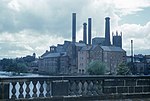Derby

Derby ( DAR-bee) is a city and unitary authority area on the River Derwent in Derbyshire, England. Derbyshire is named after Derby, which was its original county town. As a unitary authority, Derby is administratively independent from Derbyshire County Council. The population of Derby is 261,136 (2021).The Romans established the town of Derventio, which was later captured by the Anglo-Saxons and then by the Vikings who made Djúra-bý one of the Five Boroughs of the Danelaw. Initially a market town, Derby grew rapidly in the industrial era and was home to Lombe's Mill, an early British factory, Derby contains the southern part of the Derwent Valley Mills World Heritage Site. With the arrival of the railways in the 19th century, Derby became a centre of the British rail industry. Despite having a cathedral since 1927, Derby did not gain city status until 1977. Derby is a centre for advanced transport manufacturing. It is home to engine manufacturer Rolls-Royce and Alstom (formerly Bombardier Transportation) has a production facility at the Derby Litchurch Lane Works; Toyota's UK headquarters is located in the south-west of the city at Burnaston.
Excerpt from the Wikipedia article Derby (License: CC BY-SA 3.0, Authors, Images).Derby
Cathedral Square, Derby Little Chester
Geographical coordinates (GPS) Address Nearby Places Show on map
Geographical coordinates (GPS)
| Latitude | Longitude |
|---|---|
| N 52.9247 ° | E -1.478 ° |
Address
Cathedral Square
Cathedral Square
Derby, Little Chester
England, United Kingdom
Open on Google Maps







